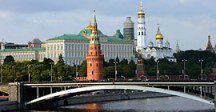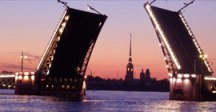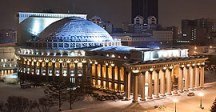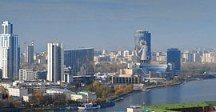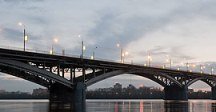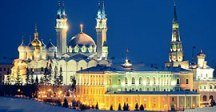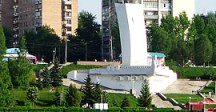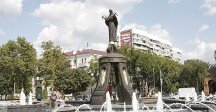Map of Volgograd
Detailed interactive map of Volgograd. Map of Volgograd with streets and numbers of houses. Satellite map of Volgograd with sights of the city.
The change between the satellite map of Volgograd and the schematic one is made in the lower left corner of the interactive map.
Volgograd
The population of the cityVolgograd: 1,004,763 people (2021)
Date of foundation of Volgograd: 1589.
Volgograd city phone code: +7 8442
Automobile code of the cityVolgograd: 34, 134
Postal code of the city Volgograd: 400001-400138
Volgograd is a Russian city in the south-east of the country. Formerly known as Stalingrad, Volgograd is a shipping port and the industrial center of Russia on the Volga River. The city is the administrative center of the Volgograd region. Its buildings and factories stretch for more than 64 kilometers along the banks of the river.
Economy of Volgograd
Steel and aluminum, machine-building products, timber, building materials and food products top the long list of products produced in Volgograd. The refinery was built in 1957, and chemicals have been produced since the 1960s.
The hydroelectric power plant provides low-cost electricity. Inland waterways and railways connect Volgograd with highly developed regions in the north and west of the country. Access to Europe is via the Volga-Don Canal, the Black Sea and the Mediterranean Sea. Volgograd State University was opened in 1978.
The history of Volgograd
The city was founded as Tsaritsyn fortress in 1589. Its name was changed to Stalingrad in 1925 in honor of Joseph Stalin, who successfully led the defense of the city in a major battle against the Whites during the Civil War.
In 1942-1943, during World War II, Stalingrad was the scene of a long, fierce battle that stopped the penetration of German troops into the Soviet Union. In 1961, the name of the city was changed to Volgograd.
What to see in Volgograd
Volgograd has a large number of sights and monuments that serve as reminders of the years of the Great Patriotic War. One of the main monuments, which bears the name "Motherland calls", stands on Mamayev Kurgan. It is one of the tallest monuments in the country, one of the Russian wonders.
Another memorable place is the Alley of Heroes near the Volga embankment. The alley is known for the fact that we still have a Poplar growing – a unique tree that survived the war. It is definitely worth visiting the city's museums. The Museum of Local Lore, the Stalin Museum, the Memorial Historical Museum and others will tell about the history of the city, its nature, culture and famous people of the country.
If you just walk around the city, you can see many interesting and unusual monuments. For example, a monument in honor of the first teacher, a monument to lovers, a monument to a plumbing fitter, etc. But the most interesting monument is the statue of Lenin, whose height is 57 meters.
Monument to Alexander Nevsky. Russian Russian Orthodox Patriarch Alexy II gave his blessing in 2006 to name Alexander Nevsky, a medieval Russian prince and saint, as the defender of the city of Volgograd. This decision was then immortalized in 2007 by the installation of a statue of the holy Prince himself in the main square of the city. Alexander is depicted in full-length armor and with a waving banner.
The Battle of Stalingrad Panorama Museum consists of four halls, which feature more than 3,500 exhibits telling about the famous battle, which is considered one of the most important battles of the Second World War and a turning point in the conflict. The exhibits include a model of the city that clearly shows the extent of the destruction of the city at the end of the battle and the gifts given to the city for its heroism.
The central square of Volgograd is the square of Fallen soldiers. It is decorated with an obelisk and an eternal flame, over which Volgograd schoolchildren stand guard on jubilee days. The square was originally created in 1920 to serve as a monument to the defenders of Tsaritsyn from the Whites during the revolution. After the war, it was again dedicated to the heroes of the Battle of Stalingrad. It is also worth noting that here is the oldest tree in Volgograd that has survived to the present day.
The watchtower of the Fire station on Volodarsky Street was built in 1897. Today, the building is protected by the state.
Monument to Grigory Zasyokin. Prince Grigory Zasyokin was the first military governor of Tsaritsyn, who served in 1589. Besides being the governor of Tsaritsyn, he also ruled Astrakhan, Samara and Saratov. This monument to him was unveiled in 2009.
The Joseph Stalin Museum on Marshal Rokossovsky Street. On Mamayev Kurgan, directly next to the memorial complex, there is a hotel and a cultural center, which houses a small museum dedicated to Joseph Stalin. This is a rather interesting museum that tells in detail about Stalin's connection with the city that once bore his name.
Monument to Komsomolets at the intersection of Lenin Avenue and Komsomolskaya Street. Like many monuments in Volgograd, the Komsomolets monument is dedicated to the people who died defending the city during the Battle of Stalingrad. This monument is dedicated specifically to the members of the Komsomol. It depicts three young men, two boys and a girl, it was opened in 1973.
Historical and memorial complex "Mamaev Kurgan". During World War II, the hill was marked on maps as "Height 102.0" and became known as the Main height of Russia. There was a fierce struggle for him because of his strategic position, and he changed hands many times.
Pavlov's House is the name given to a four-story apartment building that became the base for Sergeant Yakov Pavlov and his platoon in September 1942. 25 men managed to defend the building for 58 days, until they were liberated by Soviet troops in November 1942. After the war, the building was restored, and now there is a monument to the heroic defense.
The Volgograd Planetarium on Gagarin Street not only offers you a trip to the stars, but also allows you to take a trip to the past. The planetarium was donated to the city by East Germany in 1954 and was the pinnacle of technology at that time. The Soviet-style building is topped with a statue of a woman holding a globe, the latest work by the famous sculptor Vera Mukhina. Inside there are mosaics of Konstantin Tsiolkovsky, Yuri Gagarin and even Stalin.
The Volgograd Regional Museum of Local Lore was founded in 1914, when the city was still called Tsaritsyn. Most of the museum's original collection was destroyed during the Battle of Stalingrad, but what was evacuated in time was returned to the city in 1954, when the museum was reopened. The current museum is located in two protected buildings of the late 19th/early 20th century on Lenin Street.
The Church of St. John the Baptist. The first church of Tsaritsyn was originally built of wood in 1589 and was dedicated to St. John the Baptist. The first stone church was built in 1664. Throughout its history, the church has been associated with the Russian Cossacks.
Volgograd has several monuments to Lenin, which is not surprising, given that the city was rebuilt in the Soviet style after World War II. The main statue in the city center is located on Lenin Square.
The Volgograd Memorial Historical Museum is located in a manor house of the early 20th century and is dedicated to the events of the Russian Civil War in Tsaritsyn (as Volgograd was then called) and the vicinity of the Don River, in particular the Battle of Tsaritsyn. The building first became a museum in 1937 as the Tsaritsyn Defense Museum.
The Volgograd Art Gallery was founded in 1960 and today it presents a variety of Russian, Soviet and foreign works from the 18th century to the early 20th century, including both portraits and landscapes. The museum also has a large collection of works by the artist Ilya Mashkov, who was born in the territory of the present Volgograd region. The museum also hosts various temporary exhibitions.
The historical, ethnographic and architectural museum-Reserve "Old Sarepta" was founded in 1989 around a preserved complex of 26 buildings, which was once a settlement of the Moravian brothers in Sarepta. The colony was founded in 1765, when German settlers were invited to settle in southern Russia to develop agriculture in the Volga region - these settlers later became known as the Volga Germans.
Volgograd also boasts another of the largest existing statues: the world's largest statue of Lenin. Here Lenin stands on a 30-meter pedestal 27 meters high, towering over the trees at the beginning of the Volga-Don Canal overlooking the water and towering even over the nearby lighthouse.
Monument to the defenders of the Red Tsaritsyn. Before the famous Battle of Stalingrad, the city was the site of a fierce battle between the Reds and Whites from 1918 to 1919 as part of the Russian Civil War. The defense of Tsaritsyn is immortalized in red in this monument, which was erected in 1981 and depicts six figures.
Monument to the Chekist. In 1947, in memory of the Chekists who died defending Stalingrad during the war, a monument was erected in the form of a 22-meter obelisk topped with a statue of a soldier. A small chapel dedicated to two of Russia's most famous medieval heroes, Alexander Nevsky and Dmitry Donskoy, was added to the complex.
The main and most beautiful cathedral in Volgograd is the Cathedral of the Kazan Icon of the Mother of God, which serves as the diocesan cathedral of the Volgograd and Kamyshin diocese. The current version of the cathedral was built as a church between 1897 and 1899 in an eclectic style.
Sights of Volgograd
Mamaev Kurgan, Pavlov's House, Motherland, Gergardt Mill, the Battle of Stalingrad Museum-Reserve, Lyudnikov Island, Panikakha Monument, the Bald Mountain Memorial Complex, Kazan Cathedral, Volgograd landing stage, Barmalei Fountain, Volgograd Planetarium.
The largest cities in Russia:
2024 © Russia-Karta.ru
